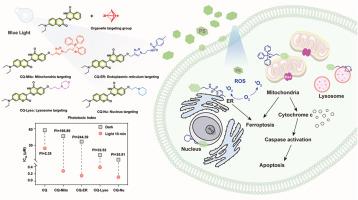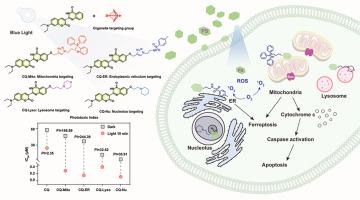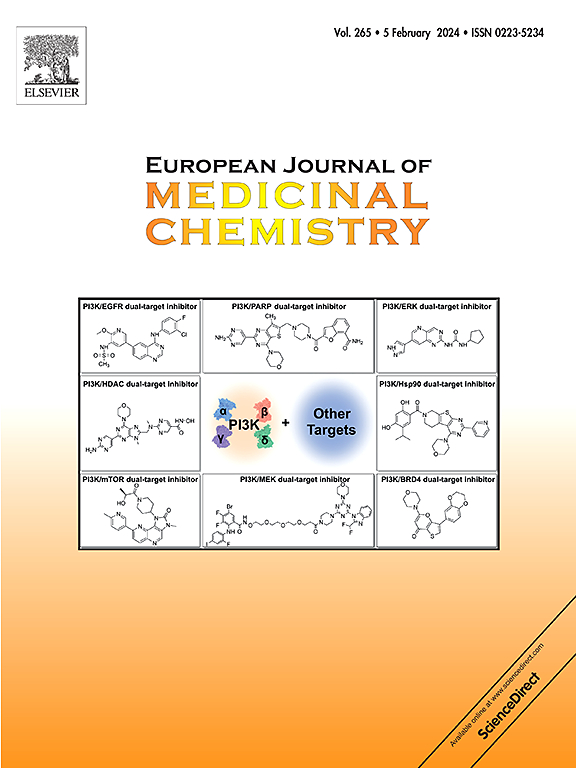香豆素-喹唑啉酮类光敏剂:通过不同的细胞死亡途径靶向线粒体和内质网以增强光疗效果
IF 6
2区 医学
Q1 CHEMISTRY, MEDICINAL
引用次数: 0
摘要
细胞器靶向光敏剂(PSs)为改善光动力疗法(PDT)提供了宝贵的工具,但有关不同细胞器如何影响光疗效果的系统研究却很有限。特别是,细胞器靶向与各种程序性细胞死亡模式之间的联系仍不清楚。在这项研究中,我们利用香豆素-喹唑啉酮(CQ)支架开发了一系列 PSs,每种 PSs 都针对不同的细胞器,包括线粒体、内质网(ER)、溶酶体和核仁。我们的研究结果表明,它们的光致透射性能高度依赖于它们的定位,光毒性指数(PI)从 2 到 245 不等。值得注意的是,线粒体靶向的 CQ-Mito 和 ER 靶向的 CQ-ER 表现出极强的光治疗性能,PI 分别为 167 和 245。我们的进一步研究发现,CQ-Mito 通过凋亡和铁凋亡两种方式导致细胞死亡,而 CQ-ER 则主要引发铁凋亡。这项研究不仅为光致猝死疗法提供了新的制剂,还深入揭示了细胞器靶向如何影响细胞死亡机制,从而为设计可控细胞死亡的 PSs 提供了启示。本文章由计算机程序翻译,如有差异,请以英文原文为准。


Coumarin-Quinazolinone based photosensitizers: Mitochondria and endoplasmic reticulum targeting for enhanced phototherapy via different cell death pathways
Organelle-targeted photosensitizers (PSs) offer valuable tools for improving photodynamic therapy (PDT), yet systematic studies on how different organelles influence phototherapeutic outcomes are limited. In particular, the connection between organelle targeting and various modes of programmed cell death remains unclear. In this study, we developed a series of PSs using the Coumarin-Quinazolinone (CQ) scaffold, each designed to target different organelles, including the mitochondria, endoplasmic reticulum (ER), lysosome, and nucleolus. Our results show that their PDT performance is highly dependent on their localization, with phototoxic index (PI) ranging from 2 to 245. Notably, the mitochondria-targeted CQ-Mito and ER-targeted CQ-ER exhibited profound phototherapeutic performances, with PI of 167 and 245 respectively. Our further study reveals that CQ-Mito causes cell death by both apoptosis and ferroptosis, while CQ-ER primarily triggers ferroptosis. This study not only provides new agents for PDT but also offers insights into how organelle targeting influences cell death mechanisms, which can shed light on the design of PSs for controlled cell death.
求助全文
通过发布文献求助,成功后即可免费获取论文全文。
去求助
来源期刊
CiteScore
11.70
自引率
9.00%
发文量
863
审稿时长
29 days
期刊介绍:
The European Journal of Medicinal Chemistry is a global journal that publishes studies on all aspects of medicinal chemistry. It provides a medium for publication of original papers and also welcomes critical review papers.
A typical paper would report on the organic synthesis, characterization and pharmacological evaluation of compounds. Other topics of interest are drug design, QSAR, molecular modeling, drug-receptor interactions, molecular aspects of drug metabolism, prodrug synthesis and drug targeting. The journal expects manuscripts to present the rational for a study, provide insight into the design of compounds or understanding of mechanism, or clarify the targets.

 求助内容:
求助内容: 应助结果提醒方式:
应助结果提醒方式:


